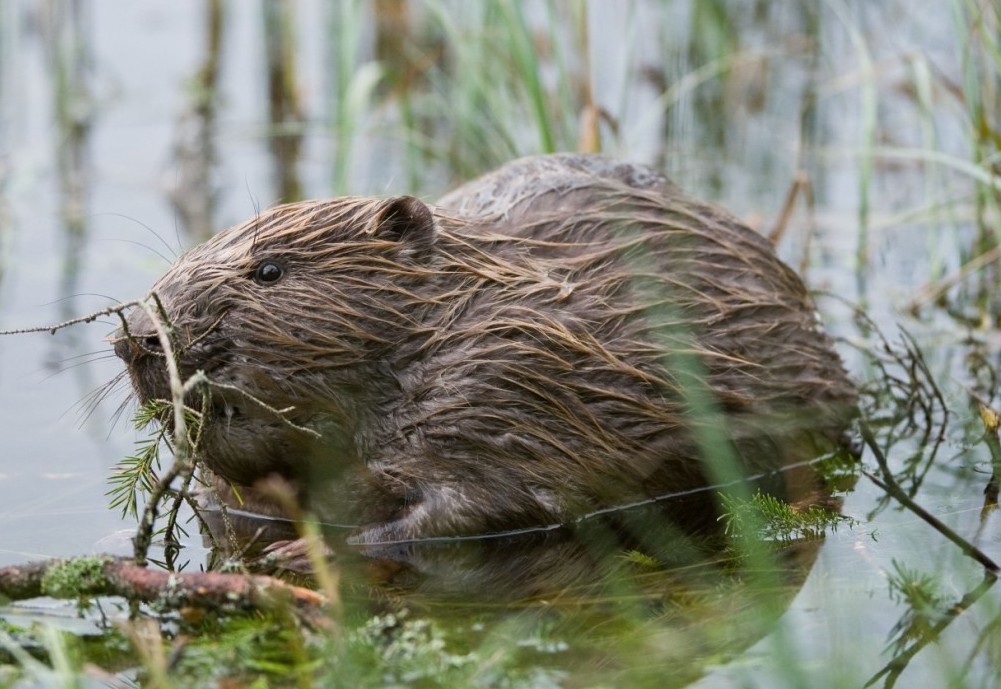Eurasian beaver

Status
Native, small, localised populations in Scotland and England; absent from Wales
Population
c. 1,500 (2023)
Scientific name
Castor fiber
The Eurasian or European beaver was once widespread in Great Britain and Europe but was hunted across its range for its fur, meat, and castoreum, a secretion from scent glands. It was extinct in England and Wales by the 12th or 13th century, and in Scotland by the 16th century. By 1900, the European population numbered only about 1,200 individuals. Since then, the population has partially recovered, with successful reintroductions in Scotland, parts of France, southern Germany and Austria. The first licenced release of beavers into the wild in Britain, however, was the Scottish Beaver Trial, which began in May 2009.
Scottish Beaver Trial On 28 May 2009, three beaver families were released in Knapdale, Argyll. In total, 16 beavers were released in several (four or five) family groups between May 2009 and September 2010, following IUCN guidelines. A three-year reinforcement project began in 2017 and a further 21 beavers released. The original trial was a partnership project by Scottish Wildlife Trust, Royal Zoological Society of Scotland, and Forestry Commission Scotland. It was financially supported by PTES.
Beavers are a ‘keystone species’ whose activities shape the local environment. By coppicing and felling trees and damming streams, they create a mosaic of habitats – a mix of wetlands, ponds, deadwood, open grassland, and dense shrub. This tends to increase biodiversity and benefit species (juvenile salmon, fr example, grow faster and are in better condition where beavers are present, and water voles do better in wetland areas created by beavers, even in the presence of mink).
Their dams create floodplains that extend the protection around their den (known as a lodge) and provide increased opportunities to forage, and benefit people, too. By slowing the flow of water, sediment can settle, trapping carbon and nutrients, improving water quality and reducing the risk of flooding downstream.
Beavers are excellent swimmers and dive for periods of five to six minutes, using their broad, flattened tail as a rudder. They burrow into the bank or use existing holes for dens (called lodges), which have entrances below the water level. If there are no suitable banks, lodges are built from branches, soil and woody debris.
Head-body length: 75 – 90cm
Tail length: 28 – 38cm
Weight: Up to 38kg
Lifespan: 7 – 8 years
Reproduction
Beavers breed mainly from December to April and litters of usually 2 – 3 kits are born in May or June. The young learn to swim within hours and leave the nest at 1 – 2 months. They are weaned in their first summer but may not disperse until two years old. They are unlikely to successfully breed until their third year.
Diet
Aquatic and herbaceous plants in summer and bark of broad-leaved trees in winter. They sometimes fell young trees in October and November to store as food during the winter.
Habitat
Areas with year-round access to water – ideally, slow-flowing rivers or lakes with deciduous woodland on their banks. They can colonise non-ideal habitat by dam-building, which extends foraging habitat.
Predators
Historically, wolf and lynx; fox and some raptors such white-tailed eagle.
Threats
They were extensively hunted in the past.
Conservation status
GB Red List: Endangered (EN); Critically Endangered (CR) in England, Endangered (EN) in Scotland.
Population size and distribution
Previously extinct in Great Britain, small, reintroduced populations exist in Scotland and England. The last survey of the population in Tayside and Forth, in 2020/21, estimated 251 active beaver territories (equivalent to roughly 954 animals). This was a 30% annual increase since the previous survey in 2017/18 and the rate of increase is expected to continue.
In 2023, the population is estimated to be more than 1,500; by 2030, the population could exceed 10,000 in Scotland (Beaver Management Report for 2022, published by NatureScot). Populations are present in Tayside and Knapdale, in Scotland, and on the river Otter in Devon, England.
Did you know?
Beavers are not very vocal, sometimes growling or hissing, but they warn each other of danger by slapping their flattened tails on the surface of the water as they dive to escape.
